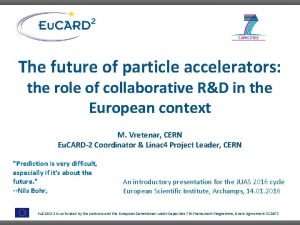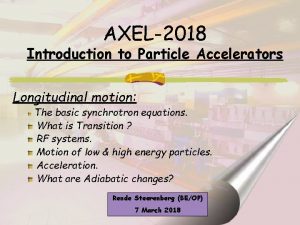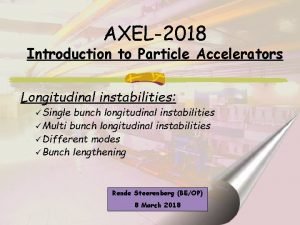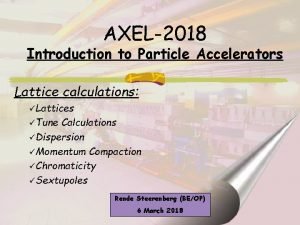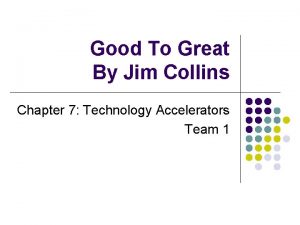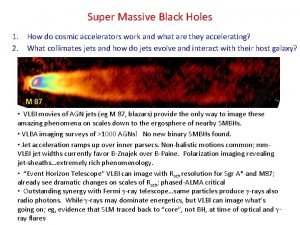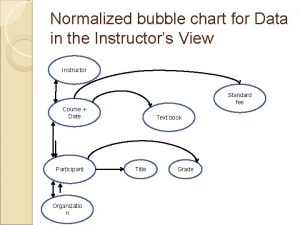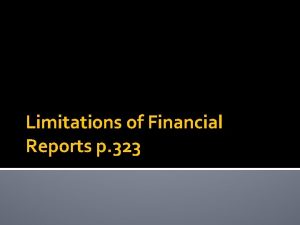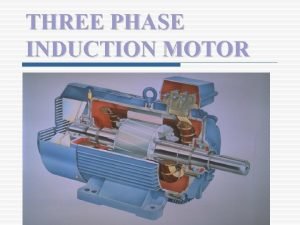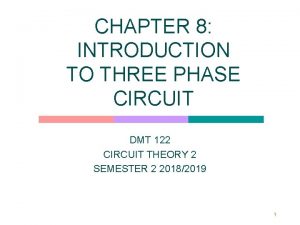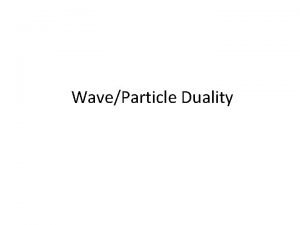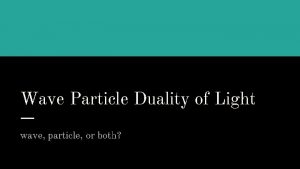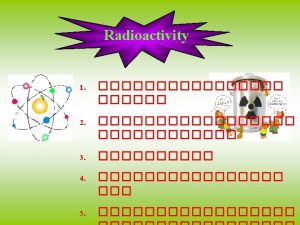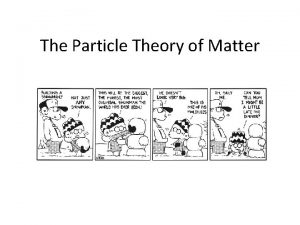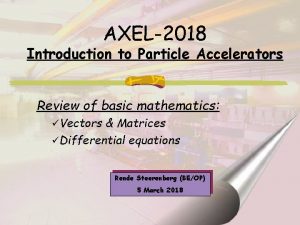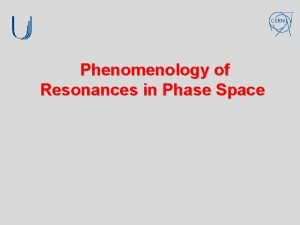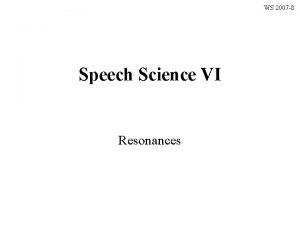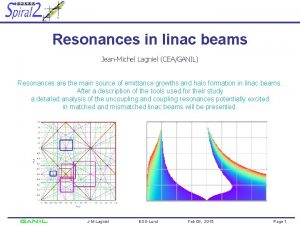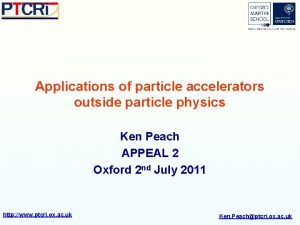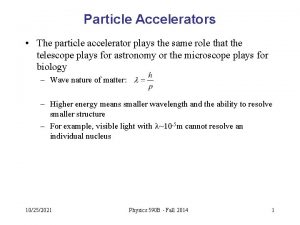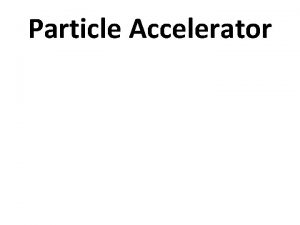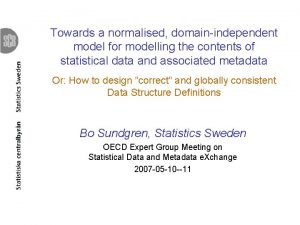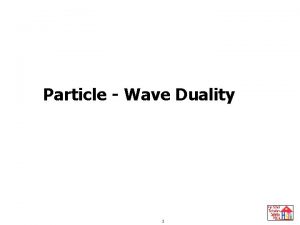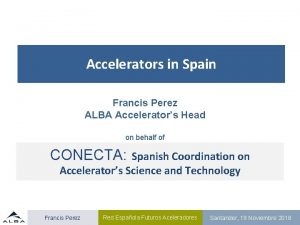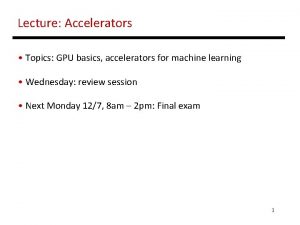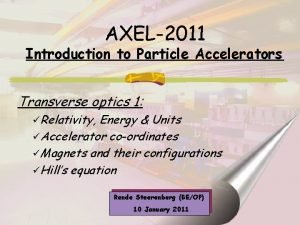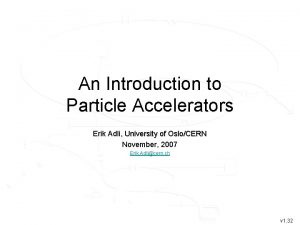AXEL2018 Introduction to Particle Accelerators Resonances Normalised Phase






























- Slides: 30

AXEL-2018 Introduction to Particle Accelerators Resonances: üNormalised Phase Space üDipoles, Quadrupoles, Sextupoles üA more rigorous approach üCoupling üTune diagram Rende Steerenberg (BE/OP) 7 March 2018

Normalised Phase Space by’ Circle of radius y ü By multiplying the y-axis by β the transverse phase space is normalised and the ellipse turns into a circle. R. Steerenberg, 7 -Mar-2018 AXEL - 2018

Phase Space & Betatron Tune ü If we unfold a trajectory of a particle that makes one turn in our machine with a tune of Q = 3. 333, we get: y by’ 0 2 p ü This is the same as going 3. 333 time around on the circle in phase space ü The net result is 0. 333 times around the circular trajectory in the normalised phase space ü q is the fractional part of Q ü So here Q= 3. 333 and q = 0. 333 R. Steerenberg, 7 -Mar-2018 AXEL - 2018 y 2πq

What is a resonance? ü After a certain number of turns around the machine the phase advance of the betatron oscillation is such that the oscillation repeats itself. ü For example: If the phase advance per turn is 120º then the betatron oscillation will repeat itself after 3 turns. ü This could correspond to Q = 3. 333 or 3 Q = 10 ü But also Q = 2. 333 or 3 Q = 7 ü ü The order of a resonance is defined as ‘n’ n x Q = integer R. Steerenberg, 7 -Mar-2018 AXEL - 2018

Q = 3. 333 in more detail 1 st turn 2 nd turn 3 rd turn Third order resonant betatron oscillation 3 Q = 10, Q = 3. 333, q = 0. 333 R. Steerenberg, 7 -Mar-2018 AXEL - 2018

Q = 3. 333 in Phase Space ü Third order resonance on a normalised phase space plot 2 nd turn 3 rd turn 1 st turn R. Steerenberg, 7 -Mar-2018 2πq = 2π/3 AXEL - 2018

Machine imperfections ü It is not possible to construct a perfect machine. Magnets can have imperfections ü The alignment in the de machine has non zero tolerance. ü Etc… ü ü So, we have to ask ourselves: What will happen to the betatron oscillations due to the different field errors. ü Therefore we need to consider errors in dipoles, quadrupoles, sextupoles, etc… ü ü We will have a look at the beam behaviour as a function of ‘Q’ ü How is it influenced by these resonant conditions? R. Steerenberg, 7 -Mar-2018 AXEL - 2018

Dipole (deflection independent of position) y’b Q = 2. 00 1 st turn y’b Q = 2. 50 2 nd turn y y 3 rd turn ü For Q = 2. 00: Oscillation induced by the dipole kick grows on each turn and the particle is lost (1 st order resonance Q = 2). ü For Q = 2. 50: Oscillation is cancelled out every second turn, and therefore the particle motion is stable. R. Steerenberg, 7 -Mar-2018 AXEL - 2018

Quadrupole Q = 2. 50 (deflection ∝ position) 1 st turn Q = 2. 33 2 nd turn 3 rd turn 4 th turn ü For Q = 2. 50: Oscillation induced by the quadrupole kick grows on each turn and the particle is lost (2 nd order resonance 2 Q = 5) ü For Q = 2. 33: Oscillation is cancelled out every third turn, and therefore the particle motion is stable. R. Steerenberg, 7 -Mar-2018 AXEL - 2018

Sextupole Q = 2. 33 (deflection ∝ position 2) 1 st turn Q = 2. 25 2 nd turn 3 rd turn 4 th turn 5 th turn ü For Q = 2. 33: Oscillation induced by the sextupole kick grows on each turn and the particle is lost (3 rd order resonance 3 Q = 7) ü For Q = 2. 25: Oscillation is cancelled out every fourth turn, and therefore the particle motion is stable. R. Steerenberg, 7 -Mar-2018 AXEL - 2018

More rigorous approach (1) ü Let us try to find a mathematical expression for the amplitude growth in the case of a quadrupole error: y’b 2πQ = phase angle over 1 turn = θ Δβy’ = kick a = old amplitude Δa = change in amplitude 2πΔQ = change in phase θ a y does not change at the kick y y = a cos(�� ) θ Dby’ 2πDQ Da In a quadrupole So we have: Δy’ = lky Only if 2πΔQ is small Δa = βΔy’ sin(�� ) = lβ sin(�� ) a k cos(�� ) R. Steerenberg, 7 -Mar-2018 AXEL - 2018

More rigorous approach (2) ü So we have: ∆a = l·�� ·sin(�� ) a·k·cos(�� ) ü Each turn θ advances by 2πQ ü On the nth turn θ = θ + 2 nπQ Sin(θ)Cos(θ) = 1/2 Sin (2θ) ü Over many turns: This term will be ‘zero’ as it decomposes in Sin and Cos terms and will give a series of + and – that cancel out in all cases where the fractional tune q ≠ 0. 5 ü So, for q = 0. 5 the phase term, 2(θ + 2 nπQ) is constant: and thus: R. Steerenberg, 7 -Mar-2018 AXEL - 2018

More rigorous approach (3) ü In this case the amplitude will grow continuously until the particles are lost. ü Therefore we conclude as before that: quadrupoles excite 2 nd order resonances for q=0. 5 ü Thus for Q = 0. 5, 1. 5, 2. 5, 3. 5, …etc…… R. Steerenberg, 7 -Mar-2018 AXEL - 2018

More rigorous approach (4) ü Let us now look at the phase θ for the same quadrupole error: y’b 2πQ = phase angle over 1 turn = θ θ Δβy’ = kick a = old amplitude Δa = change in amplitude a 2πΔQ = change in phase y does not change at the kick y s 2πDQ θ Dby’ y = a cos(θ) In a quadrupole Da 2πΔQ << Therefore Sin(2πΔQ) ≈ 2πΔQ R. Steerenberg, 7 -Mar-2018 AXEL - 2018 Δy’ = lky

More rigorous approach (5) ü So we have: ü Since: we can rewrite this as: , which is correct for the 1 st turn ü Each turn θ advances by 2πQ ü On the nth turn θ = θ + 2 nπQ ü Over many turns: ‘zero’ ü Averaging over many turns: R. Steerenberg, 7 -Mar-2018 AXEL - 2018

Stopband ü , which is the expression for the change in Q due to a quadrupole… (fortunately !!!) ü But note that Q changes slightly on each turn Related to Q Max variation 0 to 2 ü Q has a range of values varying by: ü This width is called the stopband of the resonance ü So even if q is not exactly 0. 5, it must not be too close, or at some point it will find itself at exactly 0. 5 and ‘lock on’ to the resonant condition. R. Steerenberg, 7 -Mar-2018 AXEL - 2018

Sextupole kick ü We can apply the same arguments for a sextupole: ü For a sextupole and thus ü We get : ü Summing over many turns gives: 1 st order resonance term 3 rd order resonance term ü Sextupole excite 1 st and 3 rd order resonance q=0 R. Steerenberg, 7 -Mar-2018 q = 0. 33 AXEL - 2018

Octupole kick ü We can apply the same arguments for an octupole: ü For an octupole and thus ü We get : 4 th order resonance term ü Summing over many turns gives: 2 nd order resonance term ∝ a 2(cos 4(�� +2 pn. Q) + cos 2(�� +2 pn. Q)) Amplitude squared q = 0. 5 q = 0. 25 ü Octupolar errors excite 2 nd and 4 th order resonance and are very important for larger amplitude particles. R. Steerenberg, 7 -Mar-2018 AXEL - 2018 Can restrict dynamic aperture

Resonance summary ü Quadrupoles excite 2 nd order resonances ü Sextupoles excite 1 st and 3 rd order resonances ü Octupoles excite 2 nd and 4 th order resonances ü This is true for small amplitude particles and low strength excitations ü However, for stronger excitations sextupoles will excite higher order resonance’s (non-linear) R. Steerenberg, 7 -Mar-2018 AXEL - 2018

Coupling ü Coupling is a phenomena, which converts betatron motion from one plane (horizontal or vertical) into motion in the other plane. ü Fields that will excite coupling are: ü Skew quadrupoles, which are normal quadrupoles, but tilted by 45º about it’s longitudinal axis. ü Solenoidal (longitudinal magnetic field) R. Steerenberg, 7 -Mar-2018 AXEL - 2018

Skew Quadrupole Magnetic field S N N Like a normal quadrupole, but then tilted by 45º S R. Steerenberg, 7 -Mar-2018 AXEL - 2018

Solenoid; longitudinal field (2) Particle trajectory Magnetic field Beam axis Transverse velocity component R. Steerenberg, 7 -Mar-2018 AXEL - 2018

Solenoid; longitudinal field (2) Above: The LPI solenoid that was used for the initial focusing of the positrons. It was pulsed with a current of 6 k. A for some 7 υs, it produced a longitudinal magnetic field of 1. 5 T. At the right: The somewhat bigger CMS solenoid R. Steerenberg, 7 -Mar-2018 AXEL - 2018

Coupling and Resonance ü This coupling means that one can transfer oscillation energy from one transverse plane to the other. ü Exactly as for linear resonances there are resonant conditions. n. Qh ± m. Qv = integer ü If we meet one of these conditions the transverse oscillation amplitude will again grow in an uncontrolled way. R. Steerenberg, 7 -Mar-2018 AXEL - 2018

A mechanical equivalent We can transfer oscillation energy from one pendulum to the other depending on the strength ‘k’ of the spring R. Steerenberg, 7 -Mar-2018 AXEL - 2018

General tune diagram Qv 2 Qv =5 Qh - Qv= 0 2. 75 2. 5 4 Qh =11 2. 25 2 2 2. 25 R. Steerenberg, 7 -Mar-2018 2. 5 2. 33 2. 75 2. 66 AXEL - 2018 Qh

Realistic tune diagram injection During acceleration we change the horizontal and vertical tune to a place where the beam is the least influenced by resonances. ejection R. Steerenberg, 7 -Mar-2018 AXEL - 2018

Measured tune diagram Move a large emittance beam around in this tune diagram and measure the beam losses. Not all resonance lines are harmful. R. Steerenberg, 7 -Mar-2018 AXEL - 2018

Conclusion ü There are many things in our machine, which will excite resonances: ü The magnets themselves ü Unwanted higher order field components in our magnets ü Tilted magnets ü Experimental solenoids (LHC experiments) ü The trick is to reduce and compensate these effects as much as possible and then find some point in the tune diagram where the beam is stable. R. Steerenberg, 7 -Mar-2018 AXEL - 2018

Questions…. , Remarks…? Phase space Resonance Coupling Tune diagram R. Steerenberg, 7 -Mar-2018 AXEL - 2018
 The long-term future of particle accelerators
The long-term future of particle accelerators Axel2018
Axel2018 Axel2018
Axel2018 Axel2018
Axel2018 Axel2018
Axel2018 Accelerators computer architecture
Accelerators computer architecture Slidetodoc
Slidetodoc Good to great technology accelerators
Good to great technology accelerators Good to great chapter 7 summary
Good to great chapter 7 summary Cosmic super accelerators
Cosmic super accelerators Set current query acceleration
Set current query acceleration Bubble chart normalized value
Bubble chart normalized value Limitations of financial reporting
Limitations of financial reporting Normal phase vs reverse phase chromatography
Normal phase vs reverse phase chromatography M tswett pronunciation
M tswett pronunciation Mobile phase and stationary phase
Mobile phase and stationary phase Stationary and mobile phase
Stationary and mobile phase Normal phase vs reverse phase chromatography
Normal phase vs reverse phase chromatography Phase to phase voltage
Phase to phase voltage Hplc detector types
Hplc detector types Phase to phase voltage
Phase to phase voltage Broad phase vs narrow phase
Broad phase vs narrow phase Slip frequency formula
Slip frequency formula Introduction to three phase system
Introduction to three phase system On heating solids
On heating solids Particle removal wet etch filters
Particle removal wet etch filters Wave particle duality questions
Wave particle duality questions Wave-particle duality
Wave-particle duality Particle number in micromeritics
Particle number in micromeritics Whats a beta particle
Whats a beta particle Particle theory
Particle theory
